 W
W'Ain Mallaha, also known as Eynan, was a Natufian settlement built and settled circa 10,000–8,000 BCE. The settlement is an example of hunter-gatherer sedentism, a crucial step in the transition from foraging to farming.
 W
WNahal Amud, also known as the Wadi al-Amud, is a stream in the Upper Galilee region of Israel that flows into the Sea of Galilee.
 W
WTel Arad is an archaeological tel, or mound, located west of the Dead Sea, about 10 kilometres west of the modern Israeli city of Arad in an area surrounded by mountain ridges which is known as the Arad Plain. The site is divided into a lower city and an upper hill which holds the only ever discovered "House of Yahweh" in the land of Israel. Tel Arad was excavated during 18 seasons by Ruth Amiran and Yohanan Aharoni.
 W
WAtlit Yam is an ancient submerged Neolithic village off the coast of Atlit, Israel. It has been carbon-dated as to be between 8,900 and 8,300 years old. Among the features of the 10-acre site is a stone circle.
 W
WTel Sheva and Tel Be'er Sheva are the Hebrew names, and Tell es-Seba the Arabic name of an archaeological site in southern Israel believed to be the remains of the biblical town of Beersheba. It lies east of the modern city of Beersheba and west of the new Bedouin town of Tel Sheva/Tell as-Sabi. Tel Sheva has been preserved and made accessible to visitors in the Tel Be'er Sheva National Park.
 W
WThe Chalcolithic Temple of Ein Gedi is a Ghassulian public building dating from about 3500 BCE. It lies on a scarp above the oasis of Ein Gedi, on the western shore of the Dead Sea, within modern-day Israel. Archaeologist David Ussishkin has described the site as "a monumental edifice in terms of contemporary architecture".
 W
WDan is a city mentioned in the Hebrew Bible, described as the northernmost city of the Kingdom of Israel, and belonging to the tribe of Dan. The city is identified with a tell located in northern Israel known as Tel Dan in Hebrew, or Tell el-Qadi.
 W
WEs-Skhul is a prehistoric cave site situated about 20 km (12.4 mi) south of the city of Haifa, Israel, and about 3 km (1.9 mi) from the Mediterranean Sea. The site was first excavated by Dorothy Garrod during summer of 1928. The excavation revealed the first evidence of the late Epipaleolithic Natufian culture, characterized by the presence of numerous microlith stone tools, human burials and ground stone tools. Skhul also represents an area where Neanderthals – possibly present in the region from 200,000 to 45,000 years ago – may have lived alongside these humans dating to 100,000 years ago. The cave also has Middle Palaeolithic layers.
 W
WGesher is an archaeological site located on the southern bank of Nahal Tavor, near kibbutz Gesher in the central Jordan Valley of Israel. It bears signs of occupation from two periods, the very early Neolithic and the Middle Bronze Age. The site was first excavated between 1986 and 1987 by Yosef Garfinkel of the Hebrew University of Jerusalem and between 2002 and 2004 by Susan Cohen of Montana State University. The average of 4 radiocarbon dating results suggested inhabitation of the settlement around 8000 BC.
 W
WHamadia is a kibbutz in the Beit She'an Valley, just north of Beit She'an in northern Israel. It belongs to the Valley of Springs Regional Council. In 2019 it had a population of 381.
 W
WHatula is an early Neolithic archeological site in the Judean hills south of Latrun, beside Nahal Nachshon, in Israel, 20 kilometres (12 mi) west of Jerusalem. The site is 15 metres (49 ft) above the riverbed on a rocky slope in an alluvial valley. Excavations revealed three levels of occupation in the Natufian, Khiamian and PPNA (Sultanian).
 W
WHaYonim Cave is a cave located in a limestone bluff about 250 meters above modern sea level, in the Upper Galilee, Israel.
 W
WHorvat Galil is an archaeological site in the Upper Galilee, Israel, 13 kilometres (8.1 mi) from the coast of the Mediterranean.
 W
WHorvat Uza is an archaeological site located in the northeast of the Negev desert in Israel. The site is located in the east of the Arad valley and overlooks the Qinah nahal. In ancient times, forts were established there to control the wadi road, linking Judea to Arabah and the territory of Edom. It was mentioned as Qina by Josephus in book 15 of his Antiquities.
 W
WTel Kabri is an archaeological tell containing one of the largest Middle Bronze Age Canaanite palaces in Israel, and the largest such palace excavated as of 2014. Kabri is named for the abundance of its perennial springs the presence of which has led to the site's occupation and use as a water source from the Pottery Neolithic (PN) period to the present day. Located in the Western Upper Galilee, the site was at the height of its power in the Middle Bronze, controlling much of the surrounding region. Kabri declined as a local power at the end of the Middle Bronze, but the site continued to be occupied at times, on a much reduced level, up until the 1948 Arab-Israeli War.
 W
WKebara Cave is an Israeli limestone cave locality in Wadi Kebara, situated at 60 to 65 m above sea level on the western escarpment of the Carmel Range, in the Ramat HaNadiv preserve of Zichron Yaakov.
 W
WKfar HaHoresh is a kibbutz in northern Israel. Located near Nazareth, it falls under the jurisdiction of Jezreel Valley Regional Council. In 2019 it had a population of 699.
 W
WTel Megiddo is the site of the ancient city of Megiddo whose remains form a tell, situated in northern Israel near Kibbutz Megiddo, about 30 km south-east of Haifa. Megiddo is known for its historical, geographical, and theological importance, especially under its Greek name Armageddon. During the Bronze Age, Megiddo was an important Canaanite city-state and during the Iron Age, a royal city in the Kingdom of Israel. Megiddo drew much of its importance from its strategic location at the northern end of the Wadi Ara defile, which acts as a pass through the Carmel Ridge, and from its position overlooking the rich Jezreel Valley from the west. Excavations have unearthed 26 layers of ruins since the Chalcolithic phase, indicating a long period of settlement. The site is now protected as Megiddo National Park and is a World Heritage Site.
 W
WMugharet el-Zuttiyeh is a prehistoric archaeological site in Upper Galilee, Israel. It is situated 800 m (2,600 ft) from the Nahal Amud outlet, approximately 30 m (98 ft) above the wadi bed. It was found to house a fossil today known as the "Galilee skull" and "The Palestinian Man".
 W
WMunhata is an archaeological site 11 kilometres (6.8 mi) south of Lake Tiberias, Israel on the north bank and near the outlet of Nahal Tavor on a terrace 215 metres (705 ft) below sea level.
 W
WNahal Issaron is a wadi and neolithic settlement in southern Negev, Israel. It is located at the eastern edge of Biqat Uvda, 35 kilometres (22 mi) north of the Gulf of Elat and 5 kilometres (3.1 mi) west of Arabah Rift valley. Excavations carried out by Avi Gopher and Nigel Goring-Morris in Nahal Issaron in 1980 uncovered remnants of an early pastoralist settlement belonging to the Pre-Pottery Neolithic B period.
 W
WThe Caves of Nahal Me’arot / Wadi el-Mughara, named here by the Hebrew and Arabic name of the valley where they are located, are a UNESCO Site of Human Evolution in the Carmel mountain range near Haifa in northern Israel.
 W
WOhalo is an archaeological site in Israel, in the vicinity of the Sea of Galilee. It is one of the best preserved hunter-gatherer archaeological sites of the Last Glacial Maximum, radiocarbon dated to around 23,000 BP (calibrated). It is at the junction of the Upper Paleolithic and the Epipaleolithic, and has been attributed to both periods. The site is significant for two findings which are the world's oldest: the earliest brushwood dwellings and evidence for the earliest small-scale plant cultivation, some 11,000 years before the onset of agriculture. The numerous fruit and cereal grain remains preserved in anaerobic conditions under silt and water are also exceedingly rare due to their general quick decomposition.
 W
WQesem cave is a Lower Paleolithic archeological site near the city of Kafr Qasim in Israel. Early humans were occupying the site by 400,000 until c. 200,000 years ago.
 W
WRaqefet Cave is a Late Natufian archaeological site located in Mount Carmel in the north of Israel. It was discovered in 1956. The site indicates plants were already used as food at Raqefet, before the advent of agriculture.
 W
WRujum en-Nabi Shu'ayb or Jethro's Cairn is an ancient megalithic monument, consisting of a crescent shaped heap of field stones, located some 15 kilometers from the Sea of Galilee on a fairly inaccessible hillside below Parod in Northern Israel. It has been measured as 14,000 cubic meters in volume and about 150 meters long, making it visible from satellite photos. Bronze Age pottery excavated at the site dates the construction to between 3050 BCE and 2650 BCE, which would place it before Egypt's pyramids.
 W
WShaʽar HaGolan is a kibbutz situated at the foot of the Golan Heights in the Jordan Valley area of north-eastern Israel. Located less than 1 km from the border with Jordan, it falls under the jurisdiction of Emek HaYarden Regional Council. In 2019 it had a population of 543.
 W
WThe Tabun Cave is an excavated site located at Nahal Me'arot Nature Reserve, Israel and is one of Human Evolution sites at Mount Carmel, which were proclaimed as having universal value by UNESCO in 2012. The cave was occupied intermittently during the Lower and Middle Paleolithic. In the course of this period, deposits of sand, silt and clay of up to 25 m (82 ft) accumulated in the cave. Excavations suggest that it features one of the longest sequences of human occupation in the Levant.
 W
WTel Tsaf is an archaeological site located in the central Jordan Valley, south-east of Beit She'an. It was first tested in 1978–1980 by Ram Gophna of Tel Aviv University. In 2004–2007 a large excavation project was conducted at the site by Yosef Garfinkel of the Hebrew University of Jerusalem. Since 2013 the University of Haifa and the Zinman institute of archaeology started the renewed excavation of Tel Tsaf. Tel Tsaf is dated to ca. 5200–4700 BC, sometimes called the Middle Chalcolithic, a little-known period in the archaeology of the Levant, post-dating the Wadi Rabah phase and pre-dating the Ghassulian Chalcolithic phase.
 W
W'Ubeidiya, some 3 km south of Lake Tiberias, in the Jordan Rift Valley, Israel, is an archaeological site of the Pleistocene, c. 1.5 million years ago, preserving traces of one of the earliest migration of Homo erectus out of Africa, with only the site of Dmanisi in Georgia being older. The site yielded hand axes of the Acheulean type, a hippopotamus' femur bone, and an immensely large pair of horns belonging to a species of extinct bovid.
 W
WWadi Sallah is a branch of the Wadi Fa'rah where a small cave is located in the Palestinian Tubas Governorate in the northeastern West Bank, located five kilometers southwest of Tubas. The cave was discovered and excavated by Francis Turville-Petre between 1925 and 1926. It contained an occupational Heavy Neolithic archaeological site of the Qaraoun culture. This culture was without pottery and typically used large axes for chopping lumber, cutting wood and felling trees such as the cedars of Lebanon in preparation for the domestication of emmer wheat and the Neolithic Revolution. Levels II and III of Turville-Petre's excavations revealed deposits of flints and potsherds. The pottery was later in date that the Heavy Neolithic material, which included heavy blades, massive flake scrapers, and pieces with denticulation, all similar to those found at Shemouniyeh and Wadi Fa'rah. Several arrowheads were also found that were pressure flaked, generally tanged and leaf-shaped. One of these was of the Amuq 2 type.
 W
WThe Yarmukian culture was a Pottery Neolithic A (PNA) culture of the ancient Levant. It was the first culture in prehistoric Israel and one of the oldest in the Levant to make use of pottery. The Yarmukian derives its name from the Yarmouk River, which flows near its type site of Sha'ar HaGolan, near Kibbutz Sha'ar HaGolan at the foot of the Golan Heights. This culture existed alongside the Lodian and the Nizzanim cultures to the north.
 W
WYiftahel is an archaeological site located in the Lower Galilee in northern Israel. Various salvage excavations took place here between 1992 and 2008. The best known periods of occupation are the Early Bronze Age I and Pre-Pottery Neolithic B.